The Acropolis in Athens is the largest landmark in Greece and one of the top 10 ancient sites in the world. The Acropolis was built in its present form in the 5th century BC under Pericles. During this time Athens became a large and powerful city in Greece. For the first time there was the state form of democracy. Acropolis means translated “upper city”. In former times it was an own city district with many buildings.
>>>> Tickets for the Acropolis and the museum you should book online on this link
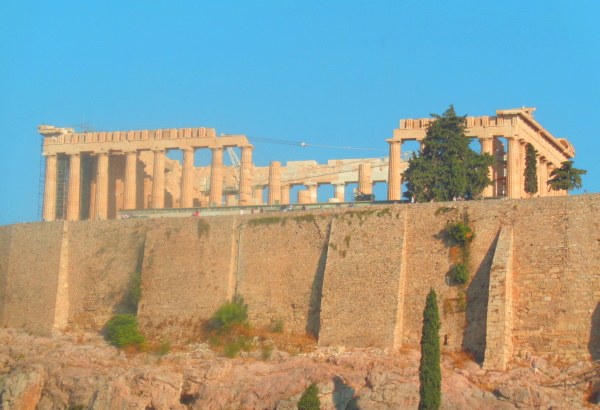
The large and widely visible building on the hill of the Acropolis in the middle of Athens is the Parthenon, an ancient temple. It was built in honour of the goddess Athena. Throughout history the Parthenon became a church and during the Ottoman rule over Athens it became a mosque. In 1687 the large building on the Acropolis was severely damaged in a war. It is still being renovated today.
Important: recommend to take part in a guided tour. Those who do not do so should prepare themselves well. Otherwise there is the danger of seeing mainly old stones. >>> You can book good guided tours on this link.
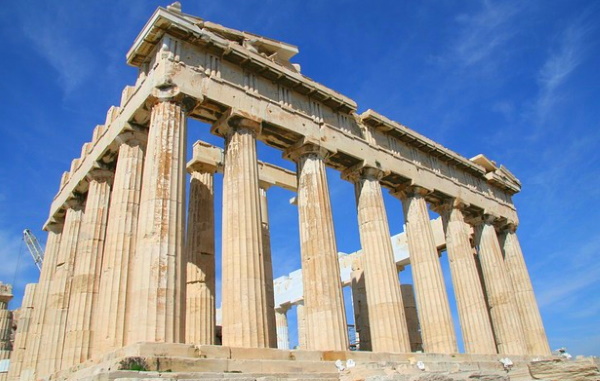
One should plan several hours for the visit of the Acropolis. The fenced area is big, there is a lot to see. The Acropolis has to be seen, even if 20 euros entrance fee is not exactly little. Those who have some more euros left should in any case participate in a guided tour. Not until a guided tour one understands the things that one sees and can classify them.
>>>> Tickets for the Acropolis and the museum you should book online on this link
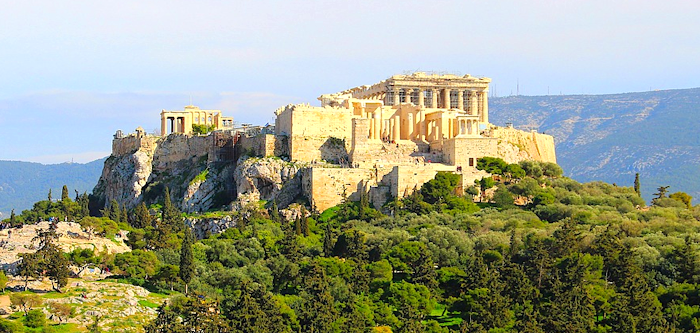
Approach Acropolis: It is best to get off at the metro station “Acropolis”. From there you walk past the Acropolis Museum up to the Acropolis. The path is partly quite steep, but the distance is feasible for a normal person in less than half an hour. One cannot go up, one has to walk up. Take some water with you when it is hot.
>>>> Tickets for the Acropolis and the museum you should book online on this link
Opening hours Acropolis: Such a world-famous sight can be visited every day, there is no closing day or the like. In summer (April to October) it is open from 8 am to 8 pm (8 to 8, easy to remember), in winter you can visit the Acropolis Athens from 8:30 to 5 pm. In the summer there is an extremely high activity, snakes form, not only at the entrance. It makes sense to come to the Acropolis Athens before 9 am. Then one also escapes the midday heat, in summer often around 40 degrees. Be sure to take some water with you.
Entrance fees to the Acropolis Athens: These have been increased considerably a few years ago. Adults now pay 20 Euros entrance fee, students and pensioners over 65 years 10 Euros. As in most national monuments and museums in Greece, children under the age of 18 do not pay admission. Take your international student card with you.
Sights in the Acropolis
Important: We recommend to take part in a guided tour. Those who do not do so should prepare themselves well. Otherwise there is the danger of seeing mainly old stones. >>> You can book good guided tours on this link.
The main building of the Athens Acropolis is undoubtedly the Parthenon. The large and mighty temple has been standing on the Acropolis hill in the middle of Athens for 2,500 years (length about 70 meters, width about 30 meters). In the temple there used to be 2 large rooms of different sizes, not much of which can be seen today. Later the temple was a Christian church (the largest church in Athens) and also a mosque during the Turkish occupation of Athens. In 1687 the large building on the Acropolis was severely damaged in a war in a gigantic explosion of a powder magazine. It is still being renovated today. The Parthenon was built as a temple in honour of the goddess Athena. In former times there was also a mighty statue of Athena in the Parthenon, which disappeared sometime in history. All objects from the Parthenon including statues, pictures etc. were brought to the Acropolis Museum downstairs near the Acropolis subway station. A new and gigantic museum that should be visited in any case. Unfortunately, many things were stolen by the English around 1801 and are now in London. Greece has been trying for decades to get these things back. The most visited and best museum in whole Greece. Our article about the Acropolis Museum
>>>> Tickets for the Acropolis and the museum you should book online on this link
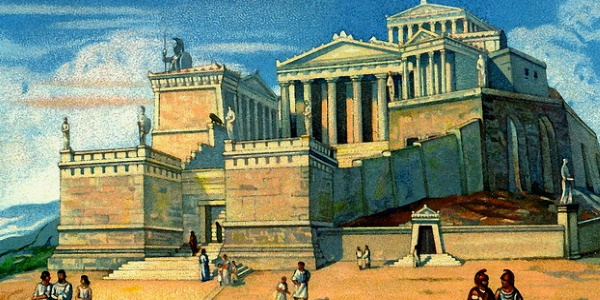
This is what the Acropolis might have looked like in ancient times
Other buildings also belong to the area of the Acropolis: The Dionysus Theatre was the most important theatre in ancient Greece. The acoustics were already extremely good in the 4th century before Christ. The drama is said to have been invented here. From Mars Hill, opposite the mountain with the Parthenon, one has the best view of Athens and the Parthenon. One should not miss the Erechtheion with the Korenhalle. The stairs of the Propylaea are also an important sight in the Acropolis. These stairs can be hardly missed, it is on the way up from the subway. The temple of Nike is another highlight. Another absolute highlight of the Acropolis Athens is also the view from above on the huge city Athens with more than 4 million inhabitants.
>>>> Tickets for the Acropolis and the museum you should book online on this link
Description of the Acropolis
The Acropolis is an ancient citadel located on a rocky outcrop above the city of Athens in Greece. It is one of the most recognizable landmarks in the world and is considered the symbol of Athens and ancient Greece. Built in the 5th century BC, the Acropolis is home to some of Greece’s most famous monuments and buildings, including the Parthenon, the Propylaea, the Erechtheion, and the Temple of Athena Nike.
The most famous of these monuments is the Parthenon, a temple dedicated to the goddess Athena. It was built in the 5th century BC and is considered the finest example of Greek architecture. The Parthenon is a rectangular temple with eight columns at each end and seventeen on each side. It was built according to the Doric architectural order, which is characterized by simple, unadorned columns and a lack of elaborate decoration.
The Propylaea is the monumental gateway to the Acropolis and was also built in the 5th century BC. The Erechtheion is another temple on the Acropolis, built in the 5th century BC in honor of Athena and Poseidon. It is known for its distinctive caryatid porch, which features six female statues as columns.
The Temple of Athena Nike, built in the 5th century BC, is a small temple dedicated to the goddess of victory, Athena Nike. It is characterized by its distinctive Ionic architecture, featuring more ornate and decorative columns.
The Acropolis has a long and fascinating history and played an important role in the development of Western civilization. Over the centuries, it has suffered numerous damages and restorations and has been the subject of numerous studies and debates among scholars and archaeologists. Today, the Acropolis is one of the most popular tourist destinations in Greece, attracting millions of visitors each year to admire its ancient beauty and learn about its rich history.
>>>> Tickets for the Acropolis and the museum you should book online on this link
Theatre of Dionysus
The Theatre of Dionysus is an ancient amphitheater on the southern slope of the Acropolis in Athens, Greece. Founded in the 5th century BC and rebuilt in the 1st century BC, it was named after the Greek god Dionysus, the god of wine, fertility, and theater. The theater was a popular gathering place for Athenians who came to watch plays, comedies, and tragedies at the city’s numerous festivals.
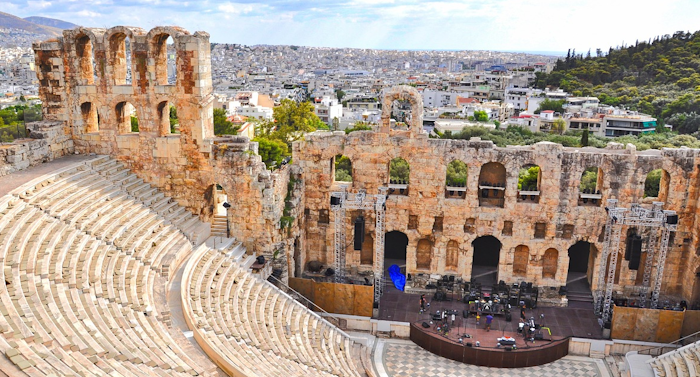
The theater was first mentioned at the end of the 6th century BC, but was rebuilt several times over the centuries. The final version of the theater was built in the 4th century BC. It was built around 1000 BC and could seat approximately 17,000 people. The theater consisted of a semicircular seating area called a koirong, divided into three sections based on social class. The lower section was for the wealthy and the upper section for the common people.
The theater was the setting for many important cultural events in the history of ancient Greece. It was the venue for famous theater competitions held during city festivals such as the Dionysia and the Panathenaia. Playwrights such as Aeschylus, Sophocles, and Euripides all performed at the Theater of Dionysus, many of them addressing themes from politics, society, and human existence. The theater was also a place for political speeches and debates, where the citizens of Athens gathered to vote on important issues. In 405 BC, Sparta is famous for destroying the Athenian fleet and ending the Peloponnesian War. A year later, the theater served as the setting for Aristophanes’ play “The Frog,” which described the political and social situation in Athens at the time.
The Theater of Dionysus continued to be used for plays and other events throughout the Hellenistic and Roman periods, but fell into ruin after the fall of the Roman Empire. The theater was partially restored in the 19th century and is now a popular tourist attraction in Athens. Visitors can tour the theater and imagine what it was like to see a performance there during the golden age of ancient Greek theater.
Mars Hill
Mars Hill, also known as Acropolis Hill, is located on the northwest side of the Acropolis in Athens, Greece. A rocky outcrop that served as an important meeting place for legal proceedings and philosophical debates in ancient Athens.
The name Mars Hill comes from the Roman god of war, Mars, but the hill was also known as the Areopagus, Greek for “Hill of Ares.” According to legend, the hill was the site where Ares, the god of justice, was tried and attempted the first murder in human history. The Athenians later used the hill as a testing ground for murder, atheism, and moral depravity. In addition to its judicial function, Mars Hill was also the center of philosophical discussion in ancient Athens. Here, the philosopher Socrates was tried and sentenced to death for corrupting the youth of Athens and disregarding the city’s gods. The philosopher Plato also used Mars Hill as the setting for his dialogues, including “Eutiflo,” which took place in the hill’s courtyard.
In Christian tradition, Mars Hill is known as the site where the Apostle Paul delivered his famous speech to the Athenians. According to the Acts of the Apostles in the New Testament, Paul arrived in Athens and was invited to speak to the people gathered at the Areopagus. He used the opportunity to introduce the Athenians to the gospel message, using their own culture and faith as a starting point for his message.
Today, visitors can climb the steps to the top of Mars Hill and enjoy breathtaking views of the surrounding city. For those interested in Christian tradition, there is a plaque commemorating Paul’s speech and its impact on the people of Athens.
>>>> Tickets for the Acropolis and the museum you should book online on this link
Temple of Nike
The Temple of Nike is an ancient temple located southwest of the Acropolis in Athens, Greece. It was built in the fifth century BC and dedicated to Athena Nike, the Greek goddess of victory.
The temple was designed by the famous Athenian architect Callicrates, who also designed the Parthenon and the Temple of Hephaestus. It was built entirely of white marble and had four Ionic columns at the front and back, and two on each side. The Temple of Nike also featured a frieze depicting scenes from the battle between Greeks and Persians during the Battle of Marathon in 490 BC. The Temple of Nike was an important symbol of Athenian power and victory. It was built to commemorate the Athenian victory over the Persians at the Battle of Marathon and also testifies to the military achievements of the Athenians during the Peloponnesian War. The temple was also a place of worship, and offerings were made to Athena Nike in the hope of gaining her favor and protection.
Over the centuries, the temple fell into disrepair and was damaged by earthquakes and wars. In the 14th century, the temple was dismantled, and its parts were used to build the city walls surrounding the Acropolis. It was then restored and the original pieces reassembled in the 15th century.
Today, visitors can visit the Temple of Nike and view its beautiful marble columns and friezes. The temple offers magnificent views of the surrounding city, including the nearby Parthenon. The temple is an important part of Athens’ rich history and a testament to the city’s artistic and architectural achievements.
Stairs of the Propylaea
The Propylaea is the monumental gateway of the Acropolis in Athens, Greece. It was designed by the architect Mnesiculus and built in the 5th century BC. It was constructed at the height of Athens’ power and prosperity. The Propylaea is located at the western end of the Acropolis and consists of two winged central buildings and a grand staircase leading to the top of a hill.
The Grand Staircase of the Propylaea is considered one of the most impressive examples of ancient Greek architecture. It was built to provide a grand entrance to the Acropolis and to impress visitors with its size and beauty. The staircase is made of marble and consists of a series of steps leading to a large platform at the top.
A staircase flanks two wings containing small halls and galleries. These spaces were used to display works of art and other treasures and provide a haven for visitors to the Acropolis. The wings also contain sculptures and other decorative elements, such as friezes depicting scenes from Greek mythology.
As visitors ascend the stairs, they can see the monumental gateway to the Acropolis, which consists of a central building with two wings. The central building has a large hall with columns and a roof supported by enormous beams. The wing contains small halls and galleries where works of art and other treasures are displayed.
Today, the Propylaea and its grand staircase are the most important sights in Athens and the main tourist attraction. Visitors can climb the steps to enjoy breathtaking views of the city and the surrounding landscape. They can also explore the wing’s halls and galleries to see the sculptures and other decorative elements that make the Propylaea an important example of ancient Greek architecture.
Top 10 Acropolis
The Parthenon is the most famous temple on the Acropolis and was dedicated to Athena Parthenos, the patron goddess of Athens. This architectural masterpiece from the 5th century BC is one of the most recognizable symbols of antiquity.
This unusual temple is known for its caryatids, six female statues serving as columns. It was dedicated to several gods, including Athena and Poseidon.
The monumental gateways of the Acropolis mark the impressive entrance to the sacred area. Built of white Pentelic marble, they are a masterpiece of classical architecture.
Temple of Athena Nike
This small, elegant temple stands at the southwest corner of the Acropolis. It was dedicated to the goddess of victory, Athena Nike, and symbolizes the success of Athens.
On the southern slope of the Acropolis lies the Theatre of Dionysus, the oldest known theater in the world. Works by famous playwrights such as Sophocles and Euripides were performed here.
Odeon of Herodes Atticus
This impressive Roman theater on the southwest slope of the Acropolis is still used for concerts and events today. It is particularly impressive when illuminated at night.
Acropolis Museum
Although not located directly on the rock, the museum houses many of the Acropolis’s most important finds, including the original Caryatids and sculptures from the Parthenon.
Views of Athens
From the Acropolis, you have a spectacular view of the entire city all the way to the Saronic Gulf. The panoramic view is especially magical at sunrise or sunset.
Acropolis Sanctuary
The sanctuary was the spiritual center of the Acropolis and the ancient city. It testifies to the deep religious significance this site had for the Greeks.
Acropolis Illuminations at Night
A visit to the Acropolis is also worthwhile after sunset – the illuminated monuments appear majestic and give the site a special atmosphere.
When was the Acropolis built?
The Acropolis of Athens was developed over many centuries, but the most famous structures we see today date from the 5th century BC. This period is known as the Golden Age of Athens under the leadership of the statesman Pericles.
Important stages in the construction of the Acropolis:
1.Early Use (from 3000 BC)
The Acropolis was already inhabited in the Neolithic period. During the Mycenaean period (c. 1600–1100 BC), it served as a fortress and religious center.
2.Archaic Period (7th–6th centuries BC)
During this period, the first temples and altars were built on the Acropolis, but they were destroyed in 480 BC during the Persian Wars.
3.Classical Period (5th century BC)
After its destruction by the Persians, Athens began rebuilding the Acropolis under Pericles. The famous buildings we admire today were built during this period:
Parthenon: Built 447–432 BC
Propylaea: Built 437–432 BC
Erechtheion: Built 421–406 BC
Temple of Athena Nike: Built c. 427–424 BC
The construction work was led by the architects Iktinus, Callicrates, and the sculptor Phidias.
What is the Acropolis? What does Acropolis mean?
The Acropolis of Athens is an ancient fortress and one of the most famous landmarks in Greece. The term “Acropolis” means “upper city” or “high part of the city” in Greek (from akros = high and polis = city). It is located on a 156-meter-high limestone cliff overlooking the city of Athens and was the religious, cultural and political center of the ancient city.